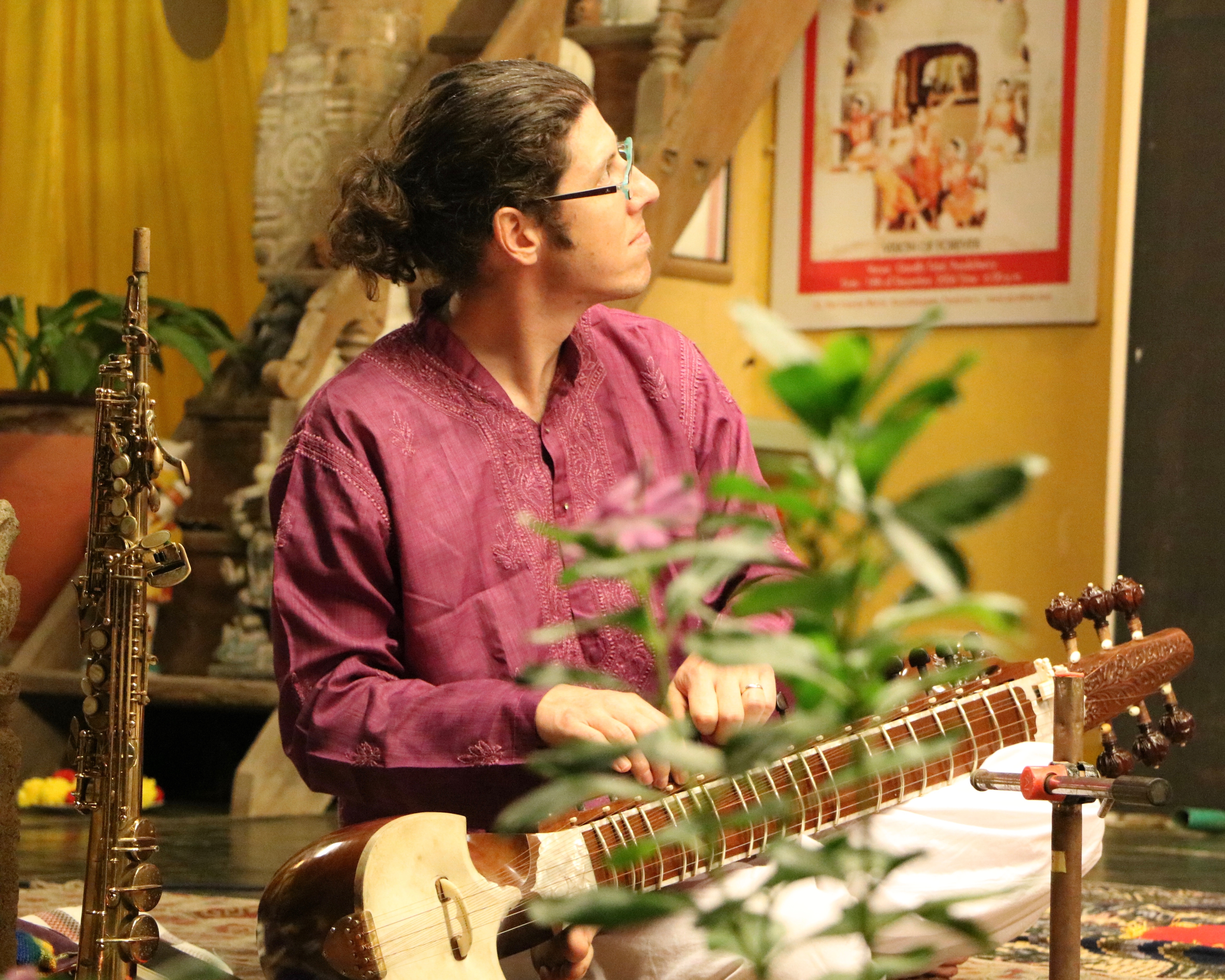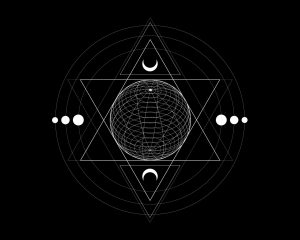
Archetypal Sound-worlds and Raga-Creations

Introduction
In pre-socratic Greek thought, cosmology, metaphysics, and mathematics were thought to culminate in a form of divine cosmic music. Music of the Spheres, a concept first attributed to Pythagoras, is a theory that posits a metaphysical principle based on universal mathematical proportions between cosmic bodies which resonate in musical relationships. In Plato’s
Timaeus time is brought forth by the rhythmic dancing of the Sun, Moon, and five other planets then known upon the stage of 12 constellations. Through the cooperative and friendly circling of these archetypal beings, eternity is permitted entry into time. Time, in other words, is said to emerge from the harmonious or regular motion of the heavens—motion regulated by mathematical harmonies. (Segall, 2015)
Musica Universalis (Music of the Spheres) written by Johannes Kepler in 1619, continues to develop these ideas from within the milieu of the European enlightenment based on new scientific discoveries. He attributes musical notes and even modes (scales) to the different planets. From this perspective, music can be seen as an archetypal sound-image of cosmic harmony. This paper will aim to explore the musicality of archetypal structures in sonic-becoming.
Theoretical Framework
This is an arts-based research-creation paper that continues the exploration of the music of the spheres through an archetypal and transcultural lens. The research-creation methodology I will utilize is based upon a post-structuralist approach developed by Manning (2016). The music developed in this paper will draw upon my life long experience as a jazz musician, and a North Indian Raga musician with over 15 years of experience (Kay, 2016). The musical result, I will call a raga-creation, is an expression of transcultural and archetypal musicality.
To develop a musical praxis through an archetypal lens in my research-creation methodology I draw upon Gilles Deleuze (1988a). “A body can be anything; it can be an animal, a body of sounds, a mind or an idea…” (pp.127). Based on this definition I will be creating a body of sounds, I am calling a sound-world. Also, notice Deleuze describes a body as an idea, which can be read as an archetype. Therefore the sound-world I will create will be a relationship of bodies as sonic-bodies, and idea-bodies.
Deleuze goes on to say that following Spinoza, “we will not define a thing by its form, nor by its organs or its functions, nor as a substance or a subject…we will define it be longitude and latitude” (pp.127). In this study, the idea-body, or archetypal body is the longitudinal axis, Deleuze calls the plan(e) of organization. “Any organization that comes from above and refers to a transcendence, be it a hidden one, can be called a theological plan: a design in the mind of god, but also an evolution in the supposed depths of nature, or a society’s organization of power. A plan of this type can be structural or genetic, and both at the same time.” (pp.128). Here it is notable how clearly Deleuze is describing an archetypal reality of becoming.
The sonic-body, in this study, will therefore be designated to what Deleuze calls the plan(e) of composition, which is “a plane of immanence…[through which] the process of composition must be apprehended for itself…there is no longer a form, but only relations of velocity…there is no longer a subject, but only individuating affective states of anonymous force” (pp128).
From this Deleuzian metaphysics, we can therefore think about how these two plan(e)s can interact to create a sound-world. The plan(e) of transcendence or organization will be the archetypal-bodies, and the plan(e) of immanence or composition will be the sound-body as a musical performance. From this perspective, the embodied performance can be seen as a rhythm between archetypal-images and sound-images.
Methodology
I derived the musical materials for this study based on the ratios of orbital distance and orbital periods from a diagram “inspired by theory and writings taken from Johannes Kepler’s Mysterium Cosmographicum (The secret of the Universe) where he explored the relationships harmonies in our solar system and sought to uncover the ‘music’ therein” (Marsden, 2011) (appendix A). I extracted all orbital ratios from the diagram (appendix B) and generated a musical mode (scale) (appendix C). Because most of the planetary ratios don’t exactly correspond to a ratio that produces a musically usable note in the Western (equal temperament) or the Indian tuning system (5-limit just intonation system), I approximated each ratio to its closest musical ratio. For example, the Earth-Mars ratio is 3:2, which is exactly a perfect 5th in just-intonation, so no adjustment was required. On the other hand, Venus-Earth is 8:13, which is very close to a major 3rd (5:4) but not quite. I approximated this ratio to a major 3rd to make musically usable materials. This musical mode can be considered a sonic-image of the solar systems dominant resonant nodes according to the Musica Universalis diagram.

Introduction
In pre-socratic Greek thought, cosmology, metaphysics, and mathematics were thought to culminate in a form of divine cosmic music. Music of the Spheres, a concept first attributed to Pythagoras, is a theory that posits a metaphysical principle based on universal mathematical proportions between cosmic bodies which resonate in musical relationships. In Plato’s
Timaeus time is brought forth by the rhythmic dancing of the Sun, Moon, and five other planets then known upon the stage of 12 constellations. Through the cooperative and friendly circling of these archetypal beings, eternity is permitted entry into time. Time, in other words, is said to emerge from the harmonious or regular motion of the heavens—motion regulated by mathematical harmonies. (Segall, 2015)
Musica Universalis (Music of the Spheres) written by Johannes Kepler in 1619, continues to develop these ideas from within the milieu of the European enlightenment based on new scientific discoveries. He attributes musical notes and even modes (scales) to the different planets. From this perspective, music can be seen as an archetypal sound-image of cosmic harmony. This paper will aim to explore the musicality of archetypal structures in sonic-becoming.
Theoretical Framework
This is an arts-based research-creation paper that continues the exploration of the music of the spheres through an archetypal and transcultural lens. The research-creation methodology I will utilize is based upon a post-structuralist approach developed by Manning (2016). The music developed in this paper will draw upon my life long experience as a jazz musician, and a North Indian Raga musician with over 15 years of experience (Kay, 2016). The musical result, I will call a raga-creation, is an expression of transcultural and archetypal musicality.
To develop a musical praxis through an archetypal lens in my research-creation methodology I draw upon Gilles Deleuze (1988a). “A body can be anything; it can be an animal, a body of sounds, a mind or an idea…” (pp.127). Based on this definition I will be creating a body of sounds, I am calling a sound-world. Also, notice Deleuze describes a body as an idea, which can be read as an archetype. Therefore the sound-world I will create will be a relationship of bodies as sonic-bodies, and idea-bodies.
Deleuze goes on to say that following Spinoza, “we will not define a thing by its form, nor by its organs or its functions, nor as a substance or a subject…we will define it be longitude and latitude” (pp.127). In this study, the idea-body, or archetypal body is the longitudinal axis, Deleuze calls the plan(e) of organization. “Any organization that comes from above and refers to a transcendence, be it a hidden one, can be called a theological plan: a design in the mind of god, but also an evolution in the supposed depths of nature, or a society’s organization of power. A plan of this type can be structural or genetic, and both at the same time.” (pp.128). Here it is notable how clearly Deleuze is describing an archetypal reality of becoming.
The sonic-body, in this study, will therefore be designated to what Deleuze calls the plan(e) of composition, which is “a plane of immanence…[through which] the process of composition must be apprehended for itself…there is no longer a form, but only relations of velocity…there is no longer a subject, but only individuating affective states of anonymous force” (pp128).
From this Deleuzian metaphysics, we can therefore think about how these two plan(e)s can interact to create a sound-world. The plan(e) of transcendence or organization will be the archetypal-bodies, and the plan(e) of immanence or composition will be the sound-body as a musical performance. From this perspective, the embodied performance can be seen as a rhythm between archetypal-images and sound-images.
Methodology
I derived the musical materials for this study based on the ratios of orbital distance and orbital periods from a diagram “inspired by theory and writings taken from Johannes Kepler’s Mysterium Cosmographicum (The secret of the Universe) where he explored the relationships harmonies in our solar system and sought to uncover the ‘music’ therein” (Marsden, 2011) (appendix A). I extracted all orbital ratios from the diagram (appendix B) and generated a musical mode (scale) (appendix C). Because most of the planetary ratios don’t exactly correspond to a ratio that produces a musically usable note in the Western (equal temperament) or the Indian tuning system (5-limit just intonation system), I approximated each ratio to its closest musical ratio. For example, the Earth-Mars ratio is 3:2, which is exactly a perfect 5th in just-intonation, so no adjustment was required. On the other hand, Venus-Earth is 8:13, which is very close to a major 3rd (5:4) but not quite. I approximated this ratio to a major 3rd to make musically usable materials. This musical mode can be considered a sonic-image of the solar systems dominant resonant nodes according to the Musica Universalis diagram.
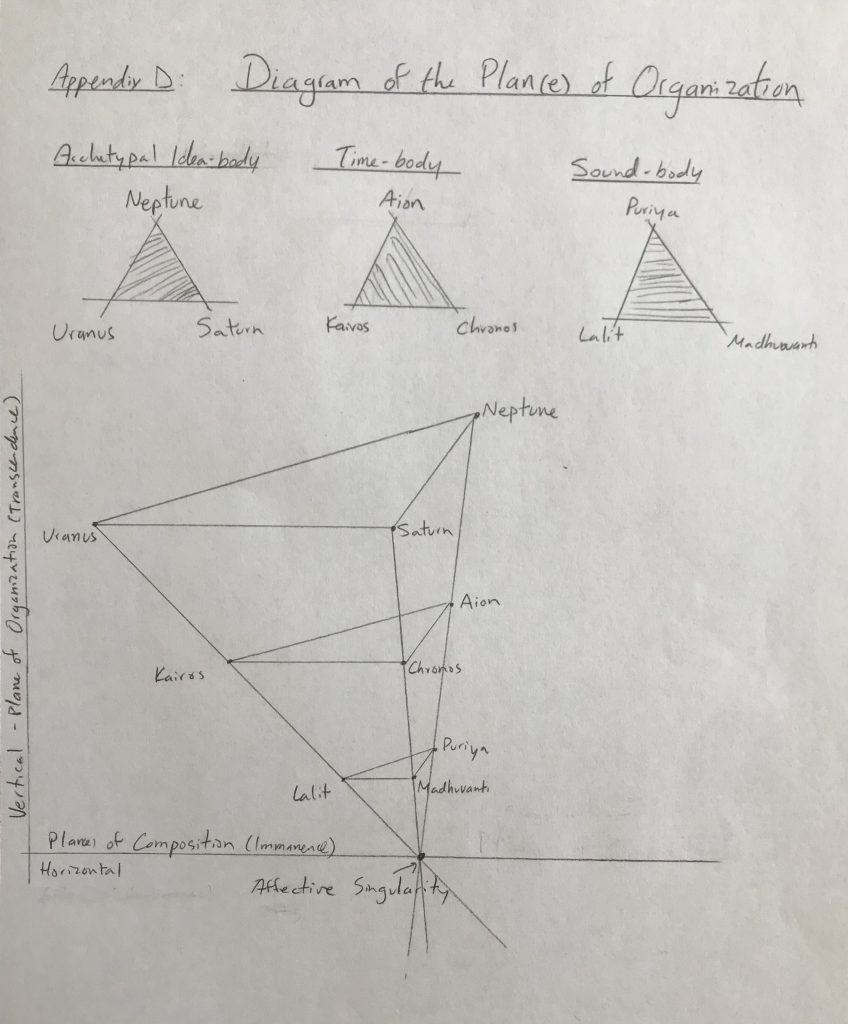
Plan(e) of Composition
Archetypal Idea-Bodies, Time-Bodies, and Raga-Bodies
I will now discuss how archetypal energies may inform the plane of composition through music composition and performance. Segall (2015) provides a phenomenological intersection in which all bodies on the plan(e) of organization can be related: “If Chronos [saturn] is the time of the ego, and Kairos [uranus] is the time of the Soul, Aion [neptune] is the time of the Self.”
Saturn – In an individuating milieu, Saturn may be considered as a will-to-crystalization. It is a power that rigidifies, progressively making structures of becoming codified and overdetermined, leading to alienation. Saturn is considered “the planet of karma”, and “makes us stand alone and know solitude; it separates us from others” (Tarnas, 1987). Saturn represents Chronos as “quantitative, homogeneous, secular time” (Segall, 2015), and from a psychological lens the time of the ego.
From the generated musical mode, I found a North Indian raga, Madhuwanti, within the collection of notes (1, 2, b3, #4, 5, 6, 7) that embodies Saturnian energy. I have learned this raga to be very introspective, self-interested, and ego-centric in a very emotional way. It depicts a pathos and deep sorrow, sometimes expressing the plight of absolute alienation from its source, destined to a world-bound fate. Rhythmically, the raga moves in simple steps and in ordered, even time, which helps to accentuate the Saturnian structure of becoming in light of the rhythm of Chronos.
Uranus – Uranus is the driving engine of becoming, inspiring change, and freedom from (Saturnian) over-determination. Sometimes calling in rebellious creativity and intellectual, it generates new bodies that open to “a radical expansion of horizons” (Tarnas, 1987). Uranus can be seen as a will-to-innovation. In my life, I have experienced this as a will-to-integration through experiences of unity-in-multiplicity. Uranus is an image of Kairos, which is “qualitative, heterogeneous, seasonal, archetypal informed time” (Segall, 2015). In this realm time, liken to Bergson’s duration, time is not determined by space, as it is in Kronos, but space is determined by heterogenous duration.
From the generated mode of music, I extracted raga Lalit (1, 3, 4, #4, b6, 7) which I see as musically depicting the life-rhythms of the soul. This raga is a sound-vehicle which elevates the pathos of the vital-life and human world, into the world of the gods. The emotional rhythm of the soul is based on an experience of the being-in-becoming, in which the many and the one dance in the creative cosmic maya.
Neptune – Neptune, embodies the will-to-transcend, and through an intense “yearning for an idea of cosmic unity” (Tarnas, 1987), produces states of mystical bliss. When all divisions are overcome, Neptune appears as Aion; “unbounded, sacred or eternal time. Aion is time as a moving image of eternity, as an eternal circle that, when we contemplate it, grants us eternal life” (Segall, 2015).
There are only a couple ragas that I think can be considered to embody Neptunian energy, and raga Puriya (1, b2, 3, #4, 6, 7) is one of them. I was able to extract this raga from the generated mode. The mood of this raga is other-worldly, and one may experience this mood a as transcendent realm of smooth space. The tone of Puriya is intensely penetrating, and its rhythm moves only when it absolutely needs. Each tone evokes a mystical liminality of infinite depth.
Results
According to the above methodology and archetypal analysis of the plan(e) of organization, the music was composed and improvised. I meditated upon each archetypal energy and entered into affective relation with the idea-body of the archetype. The flow of composition and improvisation followed an aesthetic based on the existential rhythm of the raga and the nature of the corresponding time-body. The musical result I have entitled Tri-Guna Loka (The World of Three Natures). It draws upon traditional raga techniques but combines them in contemporary ways. I musically situated myself in a liminal space between jazz improvisation and traditional raga music, producing a transcultural result. The music is performed by myself on the soprano saxophone and the esraj, a bowed Indian instrument with 21-strings.
Appendix E is the musical composition copied out in western musical notation. It is the basis from which the improvisation will develop upon based on the phenomenology of the plan(e) of organization.
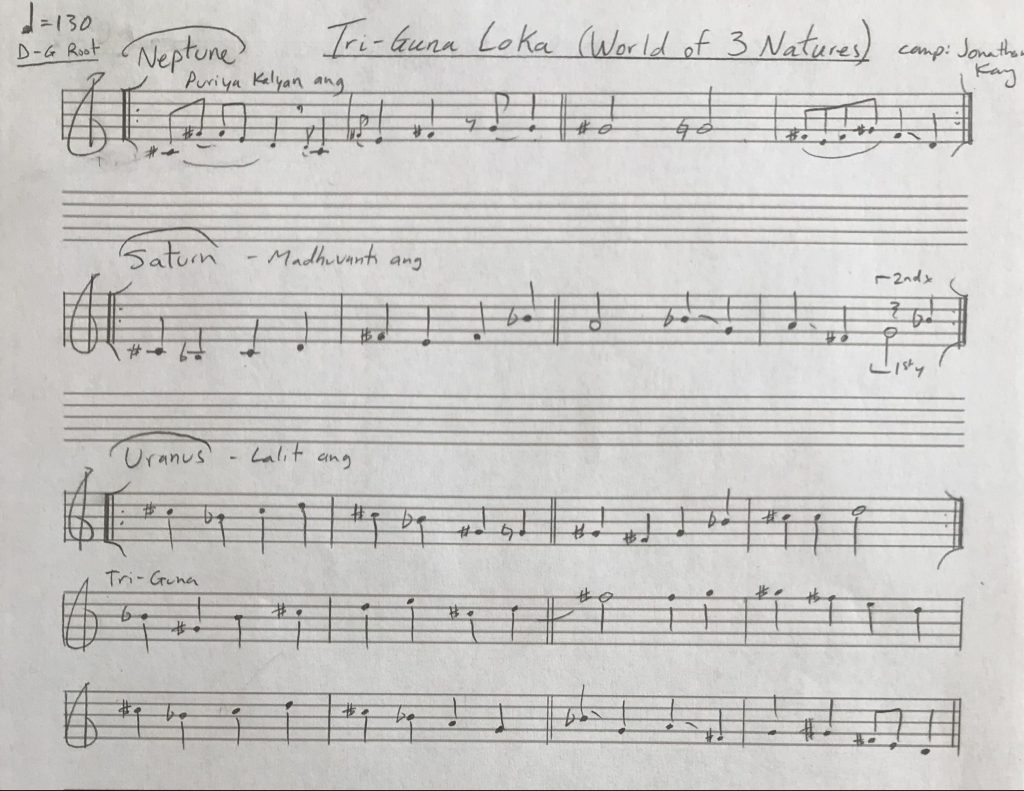
References
Deleuze, G. (1988a). Spinoza: practical philosophy. City Lights Books.
Deleuze, G. (1988). Bergsonism. Zone Books.
Ganguly, O.C. (1935). Ragas and raginis. Nalanda Books.
Kay, J. (2016). Musical transcendence: the journey of a jazz musician in to the heart of indian classical music. Critical Studies in Improvisation, Vol. 10, No.2, retrieved on 5/8/21 from: www.criticalimprov.com/index.php/csieci/article/view/3340
Warm, H. (2015). Geometric order. Retrieved from Keplerstern Verlag on 5/8/21 from: https://www.keplerstern.com/signature-of-the-celestial-spheres/geometrical- order/
Manning, E. (2016). The minor gesture. Duke University Press.
Marsden, P. (2011). Musica universalis. Retrieved on 5/8/21 from: https://flickr.com/ photos/f29/5944183384
Tarnas, R. (1987). An introduction to archetypal astrology. Retrieved on 5/8/21 from: https://cosmosandpsyche.files.wordpress.com/2013/05/introductiontoastrology1.pdf
Segall, M. (2015). Minding time: chronos, kairos, and aion in an archetypal cosmos. Retrieved on 5/8/21 from: https://footnotes2plato.com/2015/05/15/minding- time-chronos-kairos-and-aion-in-an-archetypal-cosmos/
Appendix
Appendix A – Musica Universalis Diagram
Appendix B – Orbital Ratios from Musica Universalis Diagram
Octaves:
mercury-mars 4:1, saturn-uranus 2:1, uranus-neptune 1:2, uranus-pluto 2:1
Perfect 5th
earth-mars 3:2
Perfect 4th
mercury-earth 8:3, venus-mars 1:3, earth-jupiter 1:12, neptune-pluto 2:3, mars-pluto 21:1
Augmented 4th
saturn-neptune 5:28
Major 3rd
venus-earth 8:13
Major 2rd
jupiter-uranus 1:7
Minor 6th
jupiter-saturn 2:5, mercury-venus 9:23, mars-saturn 25:4, mercury-saturn 25:1, mars-pluto 25:1
Appendix C – Musical Mode approximated from above ratio: 1, 2, 3, 4, #4, 5, b6, (7)
1 – Fundamental , 2 – major 2nd , 3 – major 3rd, 4 – perfect 4th, #4 – augmented 4th, 5 – perfect 5th ,b6 – minor 6th, 7 – natural 7th (although there was no 7th found in the ratios, I have decided to used a 7th as a leading tone for artistic reasons)
Appendix D – Diagram of the plan(e) of organization (above)
Appendix E – Diagram of the plan(e) of composition (above)
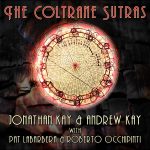 Previous Post
Previous Post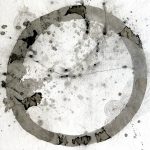 Next Post
Next Post
